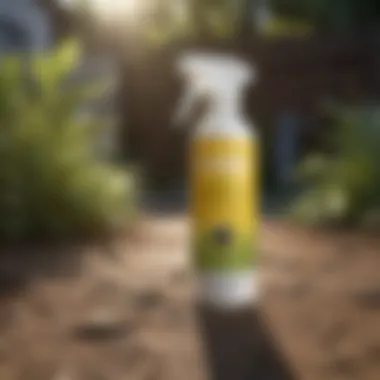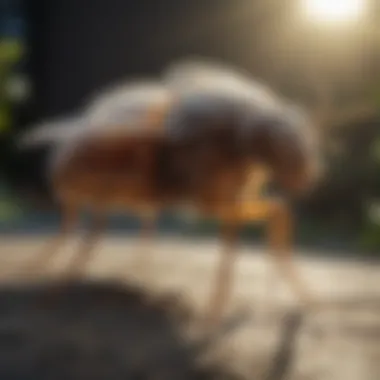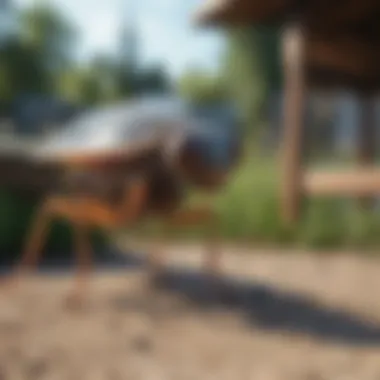The Ultimate Guide to the Best Flea Treatment for Your Yard


Preventive Pest Control Strategies
To effectively tackle pest issues in your yard, begin with comprehensive preventive pest control strategies. Start by fortifying your house's exterior protection. Seal any visible cracks using weatherproof sealant to block potential entry points for pests. Clearing debris regularly from your yard not only enhances its aesthetics but also removes potential hiding spots for pests. Implementing measures like installing door sweeps and screens can help prevent pests from entering your home.
When it comes to yard maintenance, incorporating essential routines is vital. Regularly mowing the lawn, trimming bushes, and removing standing water prevents the accumulation of organic matter that attracts pests. Employ methods such as diatomaceous earth or nematodes to keep your yard free from fleas and ticks.
Maintaining indoor cleanliness is equally crucial for effective pest control. Adopt expert cleaning tips and techniques such as vacuuming regularly, sealing food containers tightly, and decluttering to eliminate potential breeding grounds for pests. Keep your living spaces uninviting to pests by fixing leaky pipes, sealing wall cracks, and ensuring proper ventilation.
Proper garbage disposal practices significantly contribute to pest prevention. Efficient waste disposal involves securing trash bags tightly, emptying garbage bins regularly, and keeping outdoor bins tightly sealed to deter pests. Understanding the importance of proper garbage disposal emphasizes the need to avoid attracting pests through exposed waste.
Exploring innovative strategies beyond conventional methods is crucial for comprehensive pest prevention. This includes utilizing essential oils like peppermint and cedarwood to deter pests, installing ultrasonic pest repellents, and incorporating natural pest barriers such as diatomaceous earth around your home.
Understanding Fleas in Your Yard
Understanding the dynamics of fleas in your yard is crucial to effectively managing potential infestations. By gaining insights into how these pests operate in outdoor environments, homeowners can develop strategic approaches to combat them proactively. This section will delve deep into the behavior and characteristics of fleas, offering invaluable knowledge on their lifecycles, impact on pets, and associated health risks.
Overview of Fleas
Fleas are persistent parasites with a complex lifecycle that comprises egg, larva, pupa, and adult stages. This intricate development process allows them to adapt and thrive in various conditions, making them challenging to eradicate. Understanding the lifecycle of fleas is paramount in targeting the different stages to break their reproductive cycle effectively. While this presents a significant challenge, comprehending this aspect is essential for successful flea control in yards.
Impact of Fleas on Pets
The presence of fleas not only causes discomfort to pets but also poses serious health risks. Fleas can transmit diseases, cause allergic reactions, and lead to skin irritation in animals. Recognizing the impact of fleas on pets underscores the urgency of implementing effective yard treatments to safeguard the well-being of furry companions. Addressing flea infestations promptly can prevent further health complications and ensure the happiness and comfort of pets.
Health Risks Associated with Fleas
Apart from affecting pets, fleas also pose health risks to humans. These tiny pests can transmit diseases such as typhus and tapeworms, making their presence in yards a genuine concern for homeowners. Being aware of the potential health risks associated with fleas underscores the importance of thorough flea control measures. Prioritizing these aspects not only safeguards pets but also protects family members from preventable illnesses.


Choosing the Right Flea Treatment
Selecting the right flea treatment holds paramount importance when mitigating flea infestations in your yard. It plays a crucial role in ensuring the safety and well-being of your pets and family members. By opting for an effective flea treatment, you can effectively eliminate fleas from your outdoor space and prevent re-infestations. Factors to consider when choosing the suitable treatment include pet safety, the treatment's effectiveness against fleas, its environmental impact, and the ease of application.
Factors to Consider
Pet Safety
Pet safety is a critical aspect when choosing a flea treatment for your yard. Prioritizing pet safety ensures that the treatment does not pose any harm to your beloved animals. Opting for treatments that are specifically formulated to be safe for pets reduces the risk of adverse reactions. In this article, pet safety serves as a key criterion as we aim to provide solutions that safeguard both your pets and household members effectively. The unique feature of pet-friendly treatments lies in their ability to target fleas while being gentle on pets, offering a safe and reliable choice for flea control in your yard.
Effectiveness Against Fleas
The efficacy of the treatment against fleas is a crucial factor to consider. Choosing a treatment that effectively eliminates fleas at all life stages is essential for long-term control. Highlighting the treatment's strong flea-killing properties underscores its significance in eradicating flea populations effectively. In this article, focusing on the treatment's success in combating fleas showcases our commitment to providing readers with solutions that yield tangible results in flea management. The unique feature of effective flea treatments lies in their ability to break the flea life cycle, ensuring thorough eradication.
Environmental Impact
Considering the environmental impact of flea treatments is vital for maintaining ecological balance in your yard. Opting for treatments that minimize harm to beneficial organisms and the environment showcases a responsible approach to pest control. Describing how treatments can target fleas effectively while being environmentally conscious emphasizes our commitment to sustainable practices. In this article, featuring environmentally friendly options demonstrates our dedication to providing holistic solutions for flea control that are eco-friendly. The unique feature of environmentally conscious treatments lies in their ability to achieve pest control goals while minimizing environmental impact.
Ease of Application
The ease of application of a flea treatment influences its practicality and user-friendliness. Opting for treatments that are easy to apply simplifies the process of flea control and promotes consistency in treatment applications. Describing the convenience of application methods underscores their importance in ensuring hassle-free flea management. In this article, emphasizing treatments with easy application features aims to provide readers with solutions that are convenient and effective. The unique feature of easy-to-apply treatments lies in their user-friendly nature, making them suitable for all levels of users.
Best Practices For Flea Control
Flea control is a vital aspect of pet care and household maintenance. In this guide, we delve deep into the best practices for flea control to aid you in safeguarding your yard and pets from these persistent pests. Understanding the importance of implementing effective flea control measures can significantly impact the well-being of your furry companions and the overall cleanliness of your home environment.
Preventive Measures
Regular Yard Maintenance


Regular yard maintenance forms the cornerstone of flea control in outdoor spaces. By regularly mowing the lawn, trimming overgrown bushes, and removing debris, you create a less favorable environment for fleas to thrive. The key characteristic of regular yard maintenance lies in its proactive approach to preventing flea infestations, rather than just treating an existing problem. This method is beneficial as it reduces the risk of flea infestations before they become unmanageable. The unique feature of regular yard maintenance is its cost-effectiveness and long-term impact in controlling fleas in your yard.
Pet Grooming
Pet grooming plays a crucial role in flea control by ensuring that your pets' fur remains clean and free from flea infestations. Regular grooming sessions help in early detection of fleas and allow for prompt action to be taken. The key characteristic of pet grooming is its ability to maintain your pet's hygiene and overall health, reducing the likelihood of flea infestations. This method is popular as it fosters a closer bond between pets and owners while promoting a healthy living environment. The unique feature of pet grooming is its contribution to overall pet well-being and happiness.
Cleaning Indoor Spaces
Cleaning indoor spaces is essential in flea control as it eliminates potential habitats for fleas to breed and spread. By regularly vacuuming carpets, washing pet bedding, and deep cleaning furniture, you create an inhospitable environment for fleas indoors. The key characteristic of cleaning indoor spaces is its ability to target flea eggs and larvae hidden in hard-to-reach areas. This method is beneficial as it complements outdoor flea control measures, ensuring a holistic approach to flea prevention. The unique feature of cleaning indoor spaces is its immediate impact on reducing indoor flea populations and minimizing the risk of reinfestation.
Integrated Flea Management
Combining Treatments for Maximum Efficacy
Integrated flea management involves combining different treatment methods for maximum efficacy in controlling flea infestations. By using a combination of chemical treatments, natural remedies, and flea control products, you create a multi-pronged approach to tackling fleas. The key characteristic of combining treatments is its comprehensive nature, targeting fleas at different life stages and reducing the likelihood of resistance development. This method is popular among pet owners as it offers a customized approach to flea control based on individual needs and preferences. The unique feature of combining treatments is its adaptability to changing flea populations and environmental conditions, ensuring sustained effectiveness over time.
Monitoring Flea Population
Monitoring flea populations is a critical aspect of flea control to assess the effectiveness of treatments and identify any resurgence of fleas. By regularly inspecting your yard and pets for flea activity, you can track changes in population levels and adjust your control measures accordingly. The key characteristic of monitoring flea population is its proactive nature, allowing for early detection of potential infestations and prompt intervention. This method is beneficial as it provides real-time feedback on the impact of flea control measures, guiding decision-making for future strategies. The unique feature of monitoring flea population is its role in long-term flea management, ensuring sustained protection for your yard and pets against these persistent pests.
Application and Maintenance
In the realm of flea treatment for your yard, the section on Application and Maintenance stands out as a crucial pillar in ensuring a flea-free environment for your beloved pets and family. Emphasizing the significance of proper application and diligent maintenance, this segment serves as the practical implementation stage of flea control strategies detailed in this extensive guide. Application and Maintenance play a pivotal role in guaranteeing the effectiveness and longevity of the chosen flea treatment methods, safeguarding your outdoor space against these relentless pests.
Proper Application Techniques
- Spray Treatments: When delving into flea combat, Spray Treatments emerge as an indispensable weapon in your arsenal. The liquid formulas characteristic of Spray Treatments allow for broad coverage and deep penetration into nooks and crannies where fleas may lurk in your yard. The key feature of Spray Treatments lies in their versatility and ease of application, making them a favored choice among homeowners seeking comprehensive flea eradication. The unique aspect of Spray Treatments is their ability to deliver quick results by directly targeting adult fleas, eggs, and larvae, an advantage that significantly contributes to the efficacy of flea control in this narrative, albeit posing potential environmental concerns due to chemical composition.
- Granular Treatments: Next in line are Granular Treatments, offering a granulated form of flea-fighting prowess that appeals to those aiming for convenience and targeted application. The primary characteristic of Granular Treatments is their granulated texture, allowing for even distribution and gradual release of active ingredients over time. This slow-release mechanism ensures continuous protection against fleas in your yard, making Granular Treatments a popular choice for long-term flea management. The unique feature of Granular Treatments lies in their efficacy against flea infestations in larger outdoor areas, providing sustained protection without the need for frequent reapplication, although potential drawbacks include limited precision in targeting specific flea hotspots.
- Spot Treatments: Lastly, Spot Treatments present a localized approach to flea control, addressing specific areas of infestation with precision and potency. Characterized by their concentrated formulation, Spot Treatments excel in targeting hard-to-reach spots or areas with intense flea activity, offering targeted relief where it is most needed. The key characteristic of Spot Treatments lies in their ability to provide immediate relief and targeted eradication of fleas, showcasing rapid results in areas of concentrated infestation. The unique feature of Spot Treatments is their convenience and efficiency in spot-on application, ensuring precise control of flea populations in designated trouble spots, although overreliance on Spot Treatments can lead to neglect of broader flea control measures.


Regular Maintenance for Long-Term Results
- Reapplication Schedules: Tackling the persistence of fleas requires a structured approach, with Reapplication Schedules forming the cornerstone of long-term flea control success. These schedules dictate the optimal timing for reapplying chosen treatments, ensuring consistent protection against recurring flea infestations. The key characteristic of Reapplication Schedules is their ability to maintain the efficacy of flea treatments over time, preventing gaps in protection and curtailing flea resurgence. The unique feature of Reapplication Schedules lies in their flexibility and adaptability to seasonal variations in flea activity, offering a customized approach to flea control that maximizes treatment efficiency, albeit necessitating regular monitoring and adjustment based on environmental factors.
- Post-Treatment Monitoring: Following the initial application of flea treatments, Post-Treatment Monitoring steps into the spotlight, guiding homeowners towards gauging the effectiveness of their chosen strategies. This process involves observing flea activity levels, monitoring pet behavior for signs of distress or recurring infestations, and consulting with veterinarians for expert advice. The key characteristic of Post-Treatment Monitoring is its proactive nature, allowing for timely intervention in case of treatment inefficacy or persistent flea problems. The unique feature of Post-Treatment Monitoring lies in its role as a diagnostic tool for assessing treatment outcomes and refining flea control measures, emphasizing the importance of proactive surveillance in maintaining a flea-free yard while necessitating consistent vigilance and responsiveness to evolving flea challenges.
Monitoring and Evaluating Flea Treatment Effectiveness
Monitoring and evaluating flea treatment effectiveness is a crucial aspect of flea control in your yard. By understanding how to assess the impact of your chosen flea treatment, you can ensure a pest-free outdoor environment for your pets and family. This section will delve into the specific elements, benefits, and considerations related to monitoring and evaluating flea treatment effectiveness.
Assessing Treatment Outcomes
In the realm of flea control, assessing treatment outcomes plays a pivotal role in determining the success of your efforts. Let's explore the key areas of focus within this domain:
Observing Flea Activity
Observing flea activity involves closely monitoring the presence and behavior of fleas in your yard post-treatment. This proactive approach allows you to gauge the effectiveness of the chosen flea treatment method. The consistent surveillance of flea activity is an essential tool in fine-tuning your pest management strategies to achieve optimal results.
Pet Behavior Changes
Tracking changes in pet behavior serves as a valuable indicator of treatment efficacy. By observing how your pets interact with their outdoor environment after treatment, you can glean insights into the impact of the flea treatment on both your animals and the surrounding flea population. Understanding these behavioral changes empowers you to make informed decisions regarding further treatment or modifications to your flea control approach.
Consulting with Veterinarians
Consulting with veterinarians adds a professional dimension to flea treatment evaluation. Veterinarians can provide expert advice on assessing treatment outcomes, recognizing potential health risks associated with flea infestations, and recommending appropriate measures for ongoing flea control. Their specialized knowledge enhances the effectiveness of your flea treatment plan, contributing to a comprehensive approach to pet and yard health.
Addressing Persistent Flea Infestations
Persistent flea infestations require specific interventions to combat ongoing challenges effectively. Let's scrutinize the strategies tailored to address this persistent issue:
Seeking Professional Assistance
When dealing with stubborn flea infestations, seeking professional assistance becomes a strategic move. Pest control experts possess the expertise and resources to tackle severe flea problems efficiently. Their targeted approach, backed by comprehensive knowledge, ensures a thorough eradication of fleas from your yard, promoting a safe and hygienic living environment for your family.
Adopting Alternative Strategies
In cases where traditional methods fall short, adopting alternative strategies becomes imperative. Exploring unconventional yet effective flea control techniques can offer innovative solutions to persistent infestations. These alternative strategies may encompass natural remedies, advanced pest control technologies, or customized treatment plans, presenting a diverse range of options to effectively address lingering flea issues in your yard.



